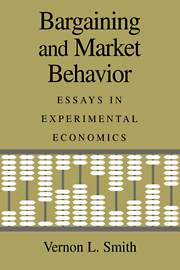Book contents
- Frontmatter
- Contents
- Preface
- Part I Economics and Psychology
- Part II Bargaining Theory, Behavior, and Evolutionary Psychology
- Part III Institutions and Markets
- INTRODUCTION
- 10 Reflections on Some Experimental Market Mechanisms for Classical Environments
- 11 Experimental Methods in the Political Economy of Exchange
- 12 Individual Rationality, Market Rationality, and Value Estimation
- 13 Market Contestability in the Presence of Sunk (Entry) Costs
- 14 The Boundaries of Competitive Price Theory: Convergence, Expectations, and Transaction Costs
- 15 Off-Floor Trading, Disintegration, and the Bid–Ask Spread in Experimental Market
- 16 Bertrand-Edgeworth Competition in Experimental Markets
- 17 An Experimental Examination of the Walrasian Tâtonnement Mechanism
- Part IV Stock Markets and Bubbles in the Laboratory
- References
- Index
16 - Bertrand-Edgeworth Competition in Experimental Markets
Published online by Cambridge University Press: 29 October 2009
- Frontmatter
- Contents
- Preface
- Part I Economics and Psychology
- Part II Bargaining Theory, Behavior, and Evolutionary Psychology
- Part III Institutions and Markets
- INTRODUCTION
- 10 Reflections on Some Experimental Market Mechanisms for Classical Environments
- 11 Experimental Methods in the Political Economy of Exchange
- 12 Individual Rationality, Market Rationality, and Value Estimation
- 13 Market Contestability in the Presence of Sunk (Entry) Costs
- 14 The Boundaries of Competitive Price Theory: Convergence, Expectations, and Transaction Costs
- 15 Off-Floor Trading, Disintegration, and the Bid–Ask Spread in Experimental Market
- 16 Bertrand-Edgeworth Competition in Experimental Markets
- 17 An Experimental Examination of the Walrasian Tâtonnement Mechanism
- Part IV Stock Markets and Bubbles in the Laboratory
- References
- Index
Summary
Oligopoly markets have been the topic of extensive theoretical and experimental research. Oligopoly market models with price setting firms provide the opportunity to explore price formation in ways that are not possible using a quantity choice (Cournot) formulation. In particular, one can consider the implications of various equilibrium and disequilibrium models of seller-pricing behavior. This study explores capacity constrained price-setting behavior in a four-seller laboratory environment. We focus on patterns of prices that arise over a relatively long time horizon (60 periods) and examine the effect of three different levels of aggregate production capacity and three levels of information about demand and rivals' costs.
Rivalry among price-setting sellers has been investigated in several prior experimental studies that have used the posted-offer environment. Prior posted-offer experiments examined a number of issues: the effects of changes in the number of sellers, the effects of the amount of information provided to sellers, the role of subject experience, the extent of market power for sellers, and the effects of changes in the market exchange institution itself. Results from many of these posted-offer experiments are discussed in Ketcham et al. (1984; hereafter KSW) and in survey articles by Plott (1982a) and Holt (1989). Experimental price and quantity outcomes have typically been compared to the competitive equilibrium, the collusive prediction, and the quantity-Cournot prediction.
Theoretical analysis of price-setting rivalry began with Bertrand's duopoly analysis of price-setting firms and the subsequent extension of Edgeworth (1925) that considered the role of production capacity constraints. Rivalry among firms that set prices, produce at constant marginal cost up to a capacity constraint, and offer a homogeneous product is typically referred to as Bertrand-Edgeworth (BE) competition.
- Type
- Chapter
- Information
- Bargaining and Market BehaviorEssays in Experimental Economics, pp. 348 - 380Publisher: Cambridge University PressPrint publication year: 2000



